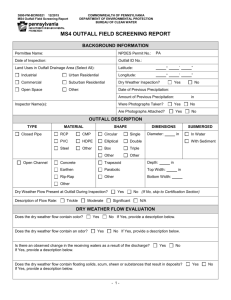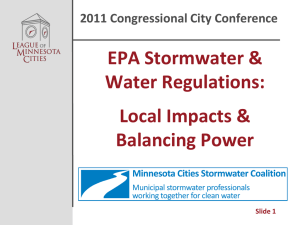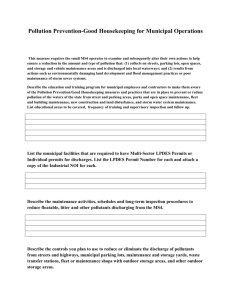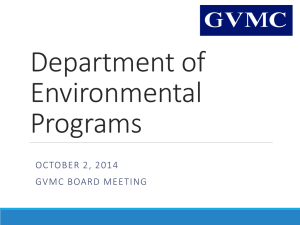IDEP_MOU_v3-0 - Huron River Watershed Council
advertisement
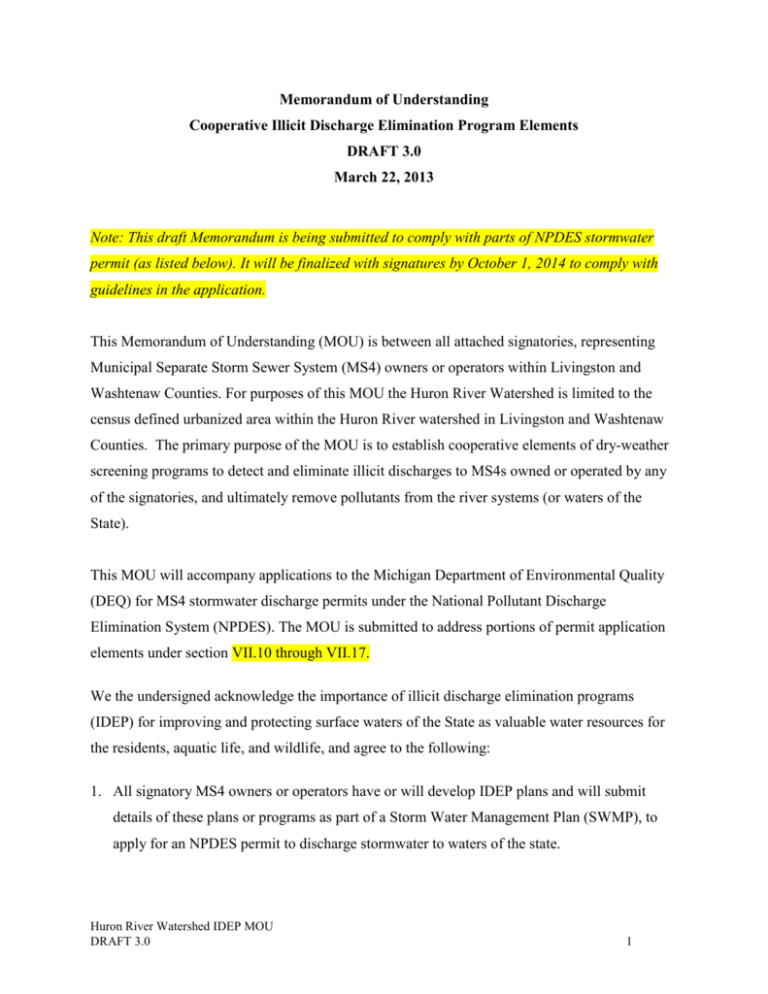
Memorandum of Understanding Cooperative Illicit Discharge Elimination Program Elements DRAFT 3.0 March 22, 2013 Note: This draft Memorandum is being submitted to comply with parts of NPDES stormwater permit (as listed below). It will be finalized with signatures by October 1, 2014 to comply with guidelines in the application. This Memorandum of Understanding (MOU) is between all attached signatories, representing Municipal Separate Storm Sewer System (MS4) owners or operators within Livingston and Washtenaw Counties. For purposes of this MOU the Huron River Watershed is limited to the census defined urbanized area within the Huron River watershed in Livingston and Washtenaw Counties. The primary purpose of the MOU is to establish cooperative elements of dry-weather screening programs to detect and eliminate illicit discharges to MS4s owned or operated by any of the signatories, and ultimately remove pollutants from the river systems (or waters of the State). This MOU will accompany applications to the Michigan Department of Environmental Quality (DEQ) for MS4 stormwater discharge permits under the National Pollutant Discharge Elimination System (NPDES). The MOU is submitted to address portions of permit application elements under section VII.10 through VII.17. We the undersigned acknowledge the importance of illicit discharge elimination programs (IDEP) for improving and protecting surface waters of the State as valuable water resources for the residents, aquatic life, and wildlife, and agree to the following: 1. All signatory MS4 owners or operators have or will develop IDEP plans and will submit details of these plans or programs as part of a Storm Water Management Plan (SWMP), to apply for an NPDES permit to discharge stormwater to waters of the state. Huron River Watershed IDEP MOU DRAFT 3.0 1 2. As part of the permit application, each IDEP will include procedures for performing field observations at outfalls identified in priority areas. Each MS4 will identify a method for prioritizing areas or outfalls within their jurisdiction. Watershed-wide priorities will be discussed at watershed group meetings for inclusion in MS4 IDEP programs. 3. On at least an annual basis, the Huron River Watershed Council (HRWC) will share results of its Water Quality Monitoring Program with signatory MS4s. Results will include data on nutrients and bacteria from short and long-term surface water sites throughout the watershed. HRWC will recommend priority drainages for IDEP. Signatory MS4s will utilize the results to determine or update priority areas and prioritize field observations at outfalls upstream of monitoring sites with water quality impairments (potential illicit discharge areas). The HRWC will review the periodic stormwater reports from signatory MS4s so that HRWC can better identify future monitoring sites. 5. In situations where one MS4 discharges into a downstream MS4, the downstream MS4 will do the following: A. Conduct field observations following procedures and schedules established in its SWMP. Any agreement for sharing the cost of such outfall screening will be made separate to this MOU. B. In the event that a potential illicit discharge is observed, downstream MS4 staff will conduct field screening and perform a source investigation following procedures in its SWMP. C. If the source of an illicit discharge is traced back to an upstream MS4 point of discharge, downstream MS4 staff will contact the designated upstream MS4 staff and provide them with investigation details and any lab analysis results within 24 hours of receipt by the downstream MS4 staff. Downstream MS4 staff will report any discharge of pollutants to waters of the state to the DEQ following procedures in its IDEP plan. 6. In the event that an illicit discharge is reported by a downstream MS4 as emanating from the upstream MS4, the upstream MS4 will do the following according to schedules and procedures in their IDEP: Huron River Watershed IDEP MOU DRAFT 3.0 2 A. MS4 staff will implement the procedure for performing a field observation and source investigation as appropriate in accordance with their IDEP. B. Following completion of source investigation, MS4 staff will communicate a report of results, including notification to the next upstream MS4 if that is the confirmed origination of the illicit discharge, in their periodic stormwater report to the DEQ. C. If an illicit discharge source is identified, the upstream MS4 will pursue remedial action with the source, as identified in its IDEP. 7. If an illicit discharge has been eliminated, staff will document the closure of the detection incident according to their agency's procedures. 8. In the event of an unresolved illicit discharge detection that was originally traced to a discharge point from the upstream MS4, the upstream MS4 will assume the responsibility of investigating the discharge and any follow-up actions in accordance with its IDEP. 9. Any signatory may terminate its involvement in this MOU at any time for any reason. Notice of such termination shall be given in writing to all other signatories prior to the effective date of termination. In such an event, the permittee terminating involvement in this MOU shall notify the DEQ prior to terminating and submit a revised application with an updated IDEP. 10. This MOU shall cover the duration of the NPDES permits issued in 2014. The signatories may agree to renew the MOU. 11. No signatory makes any admission of fact or law, or waives any claim, right, or argument against anyone or any entity by becoming a signatory to this MOU or by acting under it. Nothing in this MOU shall create any claim, right, or argument in any third party. Huron River Watershed IDEP MOU DRAFT 3.0 3 by [MS4 organization 1]: Name and Title Date by [MS4 organization 2]: Name and Title Date by the Huron River Watershed Council: Name (Executive Director) Huron River Watershed IDEP MOU DRAFT 3.0 Date 4
